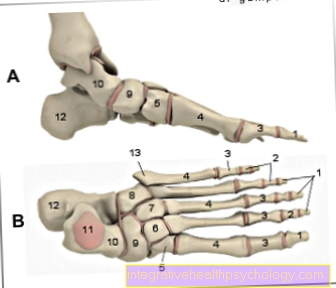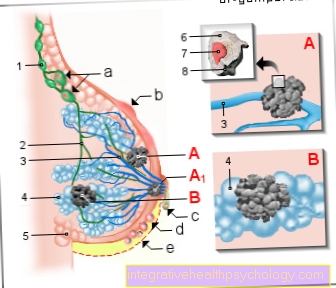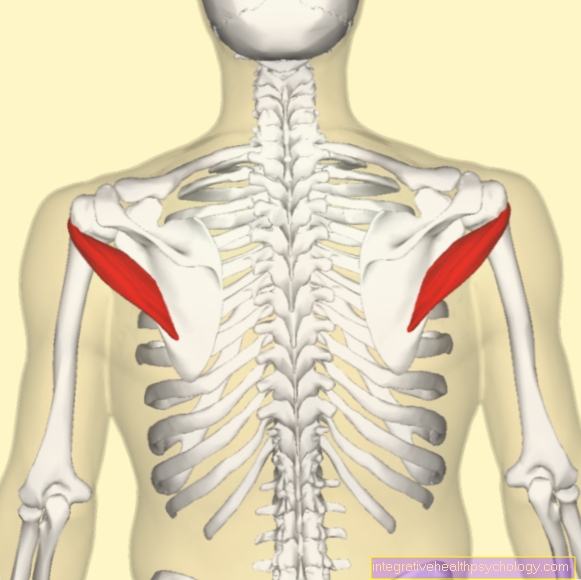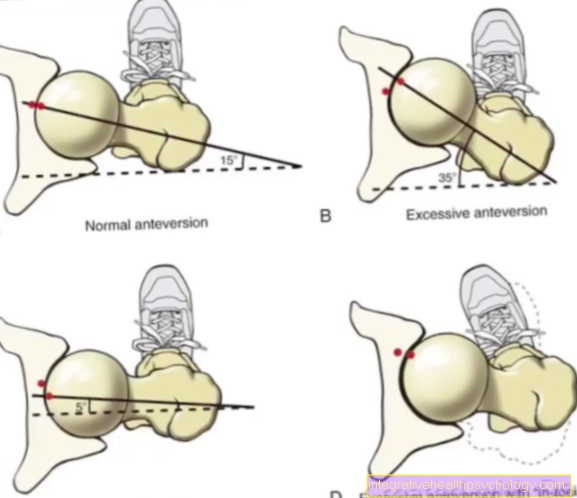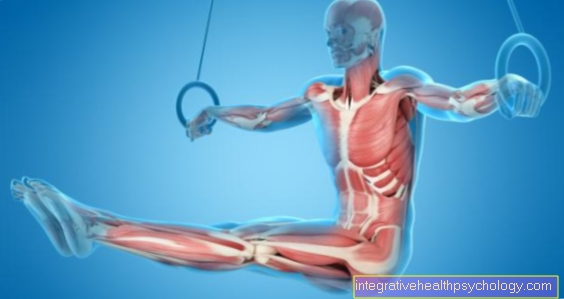Causes of Lymph Node Swelling
introduction
Lymph nodes, also called lymph glands, belong to the immune system and lie as small knots all over the body. Every person has around 600 of these nodules. Most are only 5-10 millimeters tall and cannot be felt. Exceptions are the inguinal and some cervical lymph nodes, which are up to 20mm in size even in healthy people and are therefore easy to feel. Almost everyone can feel these nodules on their own, with the flat of their hand and fingers closed, with light pressure on the fingertips.

General
They feel their way around the neck and groin as roughly hazelnut-sized, firm nodules that are easy to move and do not hurt. This is the normal state and has no disease value.
On the other hand, if a lymph node is very sensitive to touch, inflammation is usually the cause. This painful swelling is usually a temporary phenomenon and disappears again when the causative cold subsides.
A visit to a doctor is advisable if, on the other hand, a lymph node increases in size very suddenly and significantly, the swelling persists or if lymph nodes in atypical areas of the body are enlarged. Other accompanying symptoms such as night sweats, fever and weight loss are also alarm signals. Malicious causes must then also be considered.
Read more about this under Chronic swelling of the lymph nodes
General causes of lymph node swelling
If a lymph node swells, there are two groups of causes. Lymph nodes often swell as part of inflammation and much less often as part of tumor diseases. Lymph node swelling is almost always harmless and solely due to the function of the lymph nodes. The swelling arises as follows:
Pathogens such as viruses, bacteria or fungi enter the body through body openings such as the respiratory tract or through injuries in the skin. The pathogens reach the nearest lymph nodes via the lymphatic fluid and the lymphatic system. Each lymph node receives and filters the lymph fluid from a specific area of the body. The lymph nodes filter the lymph in the same way that the spleen filters the blood. The immune cells, the so-called white blood cells (B or T lymphocytes) and monitor the flowing lymphatic fluid for pathogens. If the immune cells come into contact with bacteria or viruses, they become active, the immune cells grow and multiply, so that the lymph nodes swell.
From the location of the swollen lymph node, it can be deduced in which body region the inflammation is to be found. In this way, lymph nodes that we would otherwise not notice can be felt.
Upon activation, e.g. In the context of an acute cold, they often also become sensitive to pain. This is because the swelling knot causes tension on surrounding nerve fibers, which, when stretched, send a pain signal to the brain. The swelling is nothing to worry about. On the contrary, it shows us that our immune system is working well to fight off pathogens. The cervical and inguinal lymph nodes are so prominent and permanently palpable because they ward off a large number of inflammations in the course of life and so their connective tissue increases over time. The fact that you can also feel it in the resting state has no disease value.
The cause of a lymph node swelling is often a banal or even more severe inflammation in the area of its inflow.
The second possible and unfortunately malignant cause is tumor diseases. Starting from a tumor, the so-called primary tumor, e.g. B. breast cancer, tumor cells can migrate via the lymphatic system to the nearest lymph node and a daughter ulcer there, too metastasis called, form. The lymph node becomes larger, hardens and is no longer very easy to move. This occurs much less often than the inflammatory lymph node swelling.
Feeling a swelling causes anxiety in many people. Even if the lymph node swelling is almost always harmless, you should still not be afraid to ask a doctor for advice. He can safely decide between benign and malicious cause.
Also read:
- Lymph Node Swelling - How Dangerous Is It?
- Lymph node swelling after surgery
- Causes of Lymph Node Swelling
Causes of lymph node swelling in different parts of the body
Causes of swelling of the lymph nodes in the neck
The lymph nodes are particularly numerous on the neck. The most common cause of swelling, as is generally the case with all lymph nodes, is the inflammation. In the neck area z. B. a pharynx or tonsillitis (if the tonsils are removed, the lateral cord inflammation) occur. It is usually caused by viruses, and more rarely by bacteria. Only at bacterial infections help then Antibiotics.
The pathogens can over the body orifices Mouth and nose inhaled, or through Smear infection transferred from the hands to the lining of the mouth, nose or eyes. Another entry point for pathogens are Injuries to the skin or inflamed blemishes. An inflamed tooth can also cause the nearest lymph node to swell.
Possible viral pathogens are the classic cold viruses: rhino, corona and adenoviruses. These solve you a flu-like infection out. A real flu is caused by the influenza viruses. Other viruses are the causative agents of childhood diseases measles, mumps and rubella. The childhood illness Scarlet fever is triggered by bacteria and is also often associated with swelling of the lymph nodes.
To the possible malignant causes counting Cancers as the Malignant lymphoma (Lymph gland cancer, especially the group of non-Hodgkin lymphomas), Leukemias (Blood cancer) or also Daughter ulcers (Metastases) removed tumors. The originating tumors are cancers on the neck that originate in the following organs: thyroid, lungs, nose, stomach and skin.
Causes of lymph node swelling in the armpit
In the armpit are the lymph nodes that receive the lymph fluid from the breast.
A painless, greatly enlarged lymph node can, in the worst case, be a daughter ulcer in breast cancer.
Non-Hodgkin's lymphoma from the group of malignant lymphomas can also cause swelling in the armpit. However, a more common first symptom of lymphoma is swelling of the cervical lymph nodes. There are also complaints such as fever, fatigue, weight loss and night sweats. A little night sweating is normal. One only speaks of night sweats when the clothes actually have to be changed.
In addition to a malignant cause, there is always a harmless cause. In the armpit region in particular, pathogens can occur due to simple small cuts during shaving, for example. The result is a harmless, infectious swelling of the lymph nodes. If this does not heal well, however, abscess formation can also occur. An abscess is an encapsulation of the inflammatory process that may need to be surgically removed.
Lymph node swelling in the armpit can also occur after a vaccination in the upper arm. The components of the vaccine are transported to the lymph nodes, which then react to the molecules like after an infection and produce antibodies against them. For their part, the vaccine components cannot cause any disease, but they do stimulate the formation of antibodies in the body, which in the event of a real infection lead to rapid defense mechanisms and prevent or weaken the disease. The lymph node swelling can typically occur within the first few days after vaccination.
In addition, swelling of the lymph nodes can occur during breastfeeding if the maternal breast tissue is susceptible and at risk of bacterial breast infections. These can occur due to a blocked milk, as well as small tears and injuries in the breast tissue and lead to painful chest pain, fever and other signs of inflammation. The pathogens are typically transported to the axillary lymph nodes via the lymphatic system, which then swell and trigger an immune reaction to the pathogen. As the inflammation subsides, the lymph nodes usually recede. During the illness, in addition to swelling, they can be very tender on pressure, red and overheated.
Read more on this topic:
- Lymph node swelling in the armpit - is that dangerous?
- Recognize breast cancer
- Abscess of the axilla / armpit
Causes of swelling of the lymph nodes in the groin
The lymph nodes of the groin receive the lymph fluid of the legs and the pelvic area. Infections and injuries to the lower half of the body can lead to swelling of the inguinal lymph nodes. A banal cut, for example caused by an object such as a shard, is sufficient as a gateway for pathogens. The bacteria also reach the inguinal lymph nodes via the lymph channels along the leg and are fought here. In the worst case it can lead to blood poisoning (sepsis) come when the immune system is not strong enough to fight off the pathogens.
In addition to injuries to the skin, inflammation of organs in the vicinity of the inguinal lymph nodes is also the cause of swelling of the inguinal lymph nodes. These include, for example, intestinal diseases. In men, infections in the genital area, the prostate and the epididymis can also be the cause. A woman's uterus can become inflamed.
The best-known sexually transmitted diseases are chlamydia, gonorrhea, also known as gonorrhea, syphilis, genital herpes or fungal diseases such as candida.
Read more on this topic: Lymph node swelling in the groin such as Sexually transmitted diseases
Causes of swelling of the lymph nodes in the ear
There are also lymph node stations in front of and behind the ear. The main cause is again infections in the areas that supply lymphatic fluid.
For example, a inflammation of external auditory canal, of Middle ear or one Infection of the parotid gland cause inflammation.
Inflammation of the parotid gland, too Parotid gland called, it occurs in the context of the viral mumps disease or when secretion build-up due to salivary stones.
Further infectious causes for a mainly swelling of the lymph nodes behind the ear are the following infections: the through Virus caused Teething rubella, by Parasite caused Toxoplasmosis, the transmitted by cat feces and the bacterial venereal disease syphilis. The cause can also be a carcinoma of the parotid gland or other tumor diseases in the head area. Also Skin cancer (e.g. that Malignant melanoma) can form daughter ulcers in the lymph nodes of the head region.
- Ear canal inflammation
- Signs of otitis media
Causes of swelling of the lymph nodes in the neck
A typical cause is Pfeiffer's glandular fever, too Mononucleosis or called kissing sickness. It is triggered by the Epstein-Barr virus. In addition to pronounced tonsillitis with fever and headache, symptoms include swelling of the lymph nodes in the neck and neck.
Any other inflammation in the head area can also lead to swelling of the neck lymph nodes. Examples are sore throats, gum infections, and salivary gland infections. In children, diseases such as rubella or measles can also be the cause. In general, lymph node swelling occurs more quickly in children, as their immune system is confronted with many pathogens for the first time and the reaction is more pronounced and is therefore associated with greater swelling.
Temporary lymph node sizes of up to 2 cm are harmless.
Read more about this:
- Glandular Pfeiffer fever
- Swelling of the lymph nodes in the neck
Causes of generalized lymph node swelling
Generalized lymph node swelling is when lymph nodes are swollen in more than 3 areas of the body, e.g. in the neck, groin and abdomen. Viruses that can cause this type of lymph node swelling in different parts of the body at the same time are:
- the HI virus (AIDS)
- Hepatitis B virus
- Cytomegaly virus
- Ebstein-Barr Virus
More exotic pathogens are the dengue virus or the West Nile virus. HIV usually only leads to swelling of the lymph nodes shortly after being infected. The swelling often lasts for more than 3 months, affects several parts of the body and then disappears again.
Read more on this topic: Lymph Node Swelling - What Evidence Is There It Is HIV?
The cause of painless lymph node swelling
In the case of lymph nodes, pain always indicates inflammatory, i.e. rather harmless processes. If a lymph node does not hurt and is still enlarged, this can have various causes.
In most people, the lymph nodes in the groin or under the chin are permanently and painlessly enlarged to about the size of a hazelnut or marble. This has no disease value. They are only thickened by connective tissue because a lot of inflammation has already occurred in them.
At following signs however, is one Clarification necessary:
- a diameter of more than about 1.5cm
- the swelling has been in existence for more than two weeks
- a very sudden and sharp increase in size
- a hard and coarse consistency
- when numerous swellings appear
Then there may be a malignant process such as lymph gland cancer or another cancer that has spread to the affected lymph nodes.
A rare, benign cause is that Sarcoid, in which unexplained (probably the immune system and bacteria play a role) cause, especially in the lungs but also in the lymph nodes, tissue nodules form. There is also tuberculosis, which is caused by bacteria.
That is also very rare Sinus histiocytosis, in which immune cells called histiocytes accumulate in the lymph nodes, which leads to swelling. Other rare causes are: lupus erythematosus, amyloidosis, memory disorders such as Gaucher's disease and Niemann-Pick's disease.

